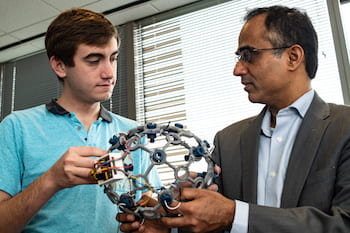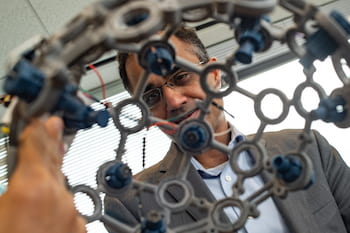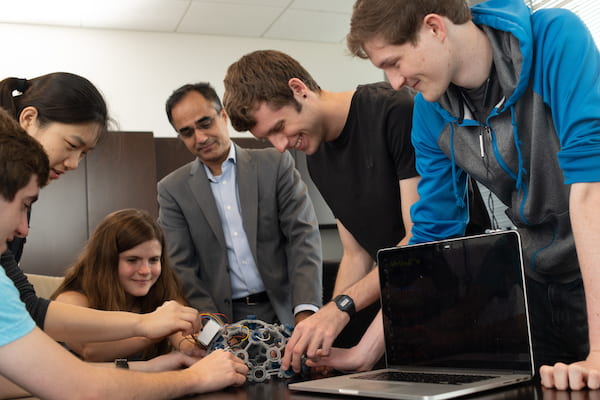NEWS RELEASE
Editor’s note: Links to video and high-resolution images for download appear at the end of this release.
David Ruth
713-348-6327
david@rice.edu
Mike Williams
713-348-6728
mikewilliams@rice.edu
Students hope to cut ties that bind seizure sufferers
Rice University engineering team develops wireless monitor for patients with intractable epilepsy
HOUSTON – (April 23, 2019) – Wiring a brain to record epileptic seizures binds a patient to a machine. It’s uncomfortable, to say the least, but Rice University engineering students want to untether them.
Axon Mobile team members — junior Aidan Curtis and seniors Sophia D’Amico, Andres Gomez, Benjamin Klimko and Irene Zhang, all electrical and computer engineering majors at Rice’s Brown School of Engineering — are developing an instrument to gather signals from a patient’s brain and send them to the computer wirelessly.
They hope their effort, part of the seniors’ capstone design requirement, will someday aid patients with epilepsy of the sort that medications can’t help, but may require surgical removal of small parts of the brain where seizures originate. First, doctors must figure out which parts are relevant, and to do so requires implanting electrodes that collect data during seizures.

Rice engineering student Andres Gomez and Dr. Nitin Tandon of the McGovern Medical School at The University of Texas Health Science Center at Houston hold a cap with sensors used to develop a wireless monitor that records seizure data from patients with intractable epilepsy. Photo by Jeff Fitlow
“That means patients need to be in the hospital for a long enough period to get the large sample size of seizures they need to understand where they’re coming from,” Curtis said. “There are a lot of costs associated with that, including psychological costs. Patients have to stay connected, and can’t move around. They can’t go home.”
“These patients are already struggling because their seizures are at the point where they don’t have any quality of life,” Klimko added. “And it turns out a lot of people with intractable epilepsy have context dependency, so if they can’t move, they might not have as many seizures.”
Because that means longer and more expensive hospital stays, any degree of freedom would be a welcome relief, Klimko said. “Far down the road, with our system, a patient could bypass those hospital-related costs in addition to getting rid of context dependency,” he said.
The students are working with Dr. Nitin Tandon, a professor of neurosurgery at the McGovern Medical School at The University of Texas Health Science Center at Houston (UTHealth), and Caleb Kemere, an assistant professor of electrical and computer engineering at Rice. Their proof-of-concept system shows high-quality data collected from electrodes in the brains of rodents transmitted wirelessly to a computer.

The system is meant to free patients from being wired to a hospital monitor for days on end waiting for seizures to occur. Photo by Jeff Fitlow
“This prototype, their embodiment of this method of wireless recording and transmission, gives us hope that we can do this in the near future,” Tandon said. “We used mostly off-the-shelf components for this, but to get to the next, more evolved level, we would need more complex and tailor-made hardware solutions.”
Tandon is also director of the epilepsy surgery program at Memorial Hermann-Texas Medical Center and an adjunct professor of electrical and computer engineering at Rice. He worked with another Rice team last year on a technique to simplify the placement of electrodes in patients.
The students’ custom circuit board currently collates signals from six implants in a model rodent and sends them wirelessly via radio frequency. “The chip we chose also has Bluetooth capability, so theoretically we could transmit data to a phone,” Zhang said, “but we’re implementing it with a proprietary radio frequency protocol for the higher data rate.”
For now, “The receiver will be hooked up to a computer to display the data,” Gomez said, “but the fact is that you, the patient, can be mobile.”
The data will likely come from one of two types of implant: stereoelectroencephalography (sEEG) or electrocorticography. In the first, single electrodes are implanted through a hole in the skull to monitor single or small groups of neurons. In the latter, a mesh is implanted under the skull to gather local field potential data from thousands or perhaps millions of neurons.

Members of the Axon Mobile team of Rice University engineering students gather with their adviser, Dr. Nitin Tandon, to discuss progress on their wireless monitor to record seizure data from patients with intractable epilepsy. From left: Andres Gomez, Irene Zhang, Sophia D’Amico, Tandon, Benjamin Klimko, and Aidan Curtis. Photo by Jeff Fitlow
Because of the complexity of the latter surgery, which involves removing a large piece of the skull, the students are gathering data from six sEEG implants. They attach their nodes to wires that protrude from the skull, which in turn send data to the central wireless unit.
The students, advised by Gary Woods, a professor in the practice of computer technology and electrical and computer engineering, worked on their project at Rice’s Oshman Engineering Design Kitchen and presented it to the public at the annual Engineering Design Showcase by fitting visitors with a 3D-printed cap with electroencephalogramsensorsand their transmitter, which sent real-time data to a visual display.
For its efforts, the team has been invited to the IEEE International Symposium on Circuits and Systems in Sapporo, Japan, May 26-29, as a finalist in the student design competition.
-30-
Visit the team’s webpage at http://oedk.rice.edu/Sys/PublicProfile/47574275/1063096.
Follow Rice News and Media Relations via Twitter @RiceUNews.
Video:
Video produced by Brandon Martin/Rice University
Related materials:
George R. Brown School of Engineering: https://engineering.rice.edu
Oshman Engineering Design Kitchen: http://oedk.rice.edu
Images for download:
https://news2.rice.edu/files/2019/04/0429_AXON-1-web-z53eah.jpg
Members of the Axon Mobile team of Rice University engineering students gather with their adviser, Dr. Nitin Tandon, to discuss progress on their wireless monitor to record seizure data from patients with intractable epilepsy. From left: Andres Gomez, Irene Zhang, Sophia D’Amico, Tandon, Benjamin Klimko, and Aidan Curtis. (Credit: Jeff Fitlow/Rice University)
https://news2.rice.edu/files/2019/04/0429_AXON-2-web-wi2u6w.jpg
Dr. Nitin Tandon of the McGovern Medical School at The University of Texas Health Science Center at Houstonholds a skull cap students at Rice University used to develop a wireless monitor that records seizure data from patients with intractable epilepsy. The system is meant to free patients from being wired to a hospital monitor for days on end waiting for seizures to occur. (Credit: Jeff Fitlow/Rice University)
https://news2.rice.edu/files/2019/04/0429_AXON-3-web-txetuf.jpg
Rice University engineering student Andres Gomez and Dr. Nitin Tandon of the McGovern Medical School at The University of Texas Health Science Center at Houstonhold a cap with sensors used to develop a wireless monitor that records seizure data from patients with intractable epilepsy. (Credit: Jeff Fitlow/Rice University)
https://news2.rice.edu/files/2019/04/0429_AXON-4-web-1jk5jad.jpg
Members of the Axon Mobile team at Rice University developing a system to allow patients with intractable epilepsy to be monitored wirelessly. From left: front, Andres Gomez and Aidan Curtis; rear, Irene Zhang, Dr. Nitin Tandon, Sophia D’Amico and Benjamin Klimko. (Credit: Jeff Fitlow/Rice University)
Located on a 300-acre forested campus in Houston, Rice University is consistently ranked among the nation’s top 20 universities by U.S. News & World Report. Rice has highly respected schools of Architecture, Business, Continuing Studies, Engineering, Humanities, Music, Natural Sciences and Social Sciences and is home to the Baker Institute for Public Policy. With 3,962 undergraduates and 3,027 graduate students, Rice’s undergraduate student-to-faculty ratio is just under 6-to-1. Its residential college system builds close-knit communities and lifelong friendships, just one reason why Rice is ranked No. 1 for lots of race/class interaction and No. 2 for quality of life by the Princeton Review. Rice is also rated as a best value among private universities by Kiplinger’s Personal Finance.






